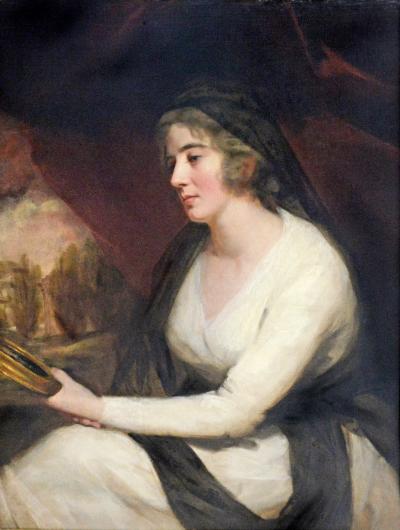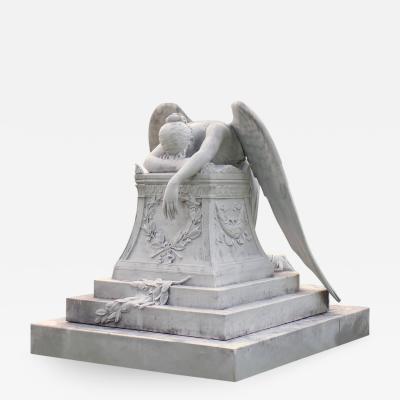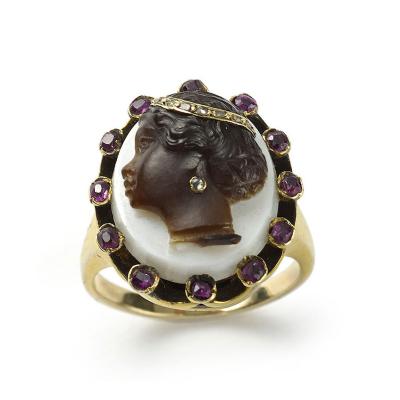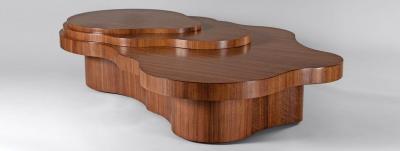Remembering Love Lost: Mourning Jewelry
This archive article was originally published in Antiques & Fine Art magazine.
The Anglo-American tradition of jewelry to mourn and remember a deceased loved one began to proliferate after the execution of Charles I in 1649, when royalists wore rings or small lockets with portraits of the king secreted beneath their clothes. After the Restoration of the English monarchy in 1660, the production of mourning jewelry gained ground primarily due to the increase in wealth across a larger segment of society. Rings, the most common type of mourning jewel, were usually distributed at funerals, and the typical late-seventeenth-century mourning ring was a plain gold band embossed with a winged skull and crossbones. The name, date of death, and age of the deceased were engraved inside the band, but by the eighteenth century, rings were often enameled black with the dedication in gold letters on the outside. By the mid-eighteenth century, bands took on a scrolling form as the rococo style emerged, and central crystals with hair or tiny paper skulls underneath also became common. Other common styles included ribbon slides, lockets and portrait miniatures, often with a panel of hairwork on the reverse.
By the early nineteenth century, the middle classes had adopted the use of mourning tokens to honor their loved ones, although they were no longer distributed at funerals. Styles had changed as well: the skulls gave way to classically robed women weeping at tombs, often depicted using appropriately muted sepia ink. The tapering “cigar band” became popular for rings, which also had enameled faces or central bezels with glazed hair compartments. Local jewelers would stock prefabricated pieces and personalize each with the insertion of a lock of hair and a memorial inscription.
The mass production of jewelry continued to advance with the nineteenth century: the development of cheaper materials and production methods made styles very uniform but also allowed all but the poor to buy mourning jewelry. By the 1840s, the Gothic Revival style popular in England had made its way to America and dominated fashion and design for the remainder of the century. Large brooches with black enamel and heavy Gothic fonts became standard mourning display.
While hairwork had been a specialty skill prior to this time, by the mid-nineteenth century it also became a popular pastime at home for American women, who could follow instructions provided in magazines. Once completed, the item could be taken to a jeweler to be incorporated into a jewel.
When Prince Albert, Queen Victoria’s consort, died in 1861, Victoria went into deep mourning, dressing in full black “window’s weeds,” including all-black jewelry. This set off an international trend towards formalized mourning. At the same time, America was plunged into the Civil War; loss of life was extensive, furthering the desire for mourning jewelry. Departing soldiers would often leave a lock of hair with their loved ones, which could become part of a mourning jewel should the man not return from war.
By the time Queen Victoria died in 1901, the mourning jewelry industry had started to decline. New attitudes towards public and private mourning, as well as the increasing removal of death from the realm of the family and home to the funeral parlor, did much to contribute to its demise.
This winged death’s-head band would have been presented to close friends and family of Mary (Partridge) Belcher, the first wife of Governor Jonathan Belcher. The inscription inside the band reads, “Honoble Madm. Belcher ob. 6 Oct 1736 AE 51[.]” The hallmark EW in a rectangle identifies the goldsmith as Bostonian Edward Winslow.
In the shape of a double heart with faceted crystals and a center suspension loop, as well as two back loops for a ribbon, this locket contains the hair of both Mary (Partridge) Belcher and her husband, Governor Jonathan Belcher of the Massachusetts Bay Colony. It commemorates Mary, who died in 1736. Slides, popular during the seventeenth and eighteenth centuries as love tokens as well as mourning jewels, were usually worn on ribbons around the wrist or the neck. The heavily faceted rock crystals on the front of this jewel are known as Stuart crystals, named for Charles I. The dark hair under the left crystal is Mary’s, according to the inscription on the back, “The Honle/Md Belchers/hair cut of/Octr 6.1736 She/being near/51 Years Old[.]“ The other inscription, “Govr Belchers/hair Cut of/Jany 8. 173/ When he enterd/the 57 Year/of his Age[,]” identifies the blond hair as Jonathan’s, added to demonstrate his sense of loss.
The practice of distributing rings at funerals was common in the eighteenth century for those who could afford it. Rings of varying quality were given to the funeral participants, including clergy, pallbearers, and community notables. The value of the ring given reflected the relationship to the deceased or the social standing of the participant. Caroline of Brandenburg-Ansbach, queen consort of King George II, died on November 20, 1737; her funeral was held in London the following month. She was the last consort to be buried in Westminster Abbey. This ring could have been given to an attendant, who would merit a gold ring with a hair relic, while a close family member would have received something more sumptuous.
These two typically rococo style rings, each with three joined enameled scrolls, commemorate an infant son and his mother, Mary (Otis) Gray. The daughter of James and Mary (Allyne) Otis of Barnstable, Mass., Mary had two siblings who played prominent roles in the American Revolution: James Otis Jr. and Mercy (Otis) Warren. Mary had wed Boston merchant John Gray, who was a Tory, in 1761. The rings for her and her son share a band style and the rayed mount popular at the time, but differ in the jewels: his features a gold foil skull set beneath a square crystal flanked by two round crystals, and hers, a center amethyst with faceted stones. The worn condition of the gem indicates it was a much treasured and worn memento. The two dedications read, respectively, “J: GRAY./.OB: 17. SEP./.1763. AE 6D” and “M: GRAY/OB: 5 NOV/1763. AE. 33.”
Sepia on ivory mourning miniatures were popular for brooches, rings, and lockets from 1765 to 1800. While the standard trope was a neoclassical female mourner, this brooch uses the more unusual image of a male mourner, who would typically represent an actual relative of the deceased.
Jonathan Deare, a lawyer from Perth Amboy, New Jersey, served in the New Jersey militia and as a deputy to the first Provincial Congress in 1775. He represented his county in the Assembly of the Legislature under the state constitution during the American Revolution. He married Frances Phillips in 1775 and the couple settled in Princeton, where they had five children. Sometime in the 1780s, Deare also accepted a position as Naval Officer of Amboy, the port of entry, and the family moved to New Brunswick, New Jersey.
The daughter of Elizabeth Bowdoin and Sir John Temple, Elizabeth Bowdoin (Temple) Winthrop grew up primarily in the Boston home of her maternal grandfather, Massachusetts governor James Bowdoin. Broadly admired as a cultured woman, she was active in Boston society and married Massachusetts politician Thomas Lindall Winthrop in 1786. Created after her death in 1825, this ring combines elements of Federal style (rectangular hair window and tapered band) with the Gothic Revival style that appeared in jewelry design by 1820 (thick gold, elaborate floral engraving, and extensive use of black jet). Ten round, faceted jet stones surround the hair compartment, augmented with three more set in each shoulder. Engraving occupies every visible gold surface on the face of the ring, creating a heavy, ornate, opulent-looking ring. It is engraved with the words “Elizabeth Bowdoin Winthrop Obt July 23, 1825 AE 55.”
This brooch memorializes the death of two sisters from the prominent Haven family of Portsmouth, New Hampshire. The dedication engraved on the back reads, “Ann Mary H. Cheever died July 4, 1826 aged 28 years Augusta Haven died June 18, 1826 aged 21 years.” The front compartment contains the hair of both sisters woven together. Both white and black enamel are used in this brooch: white for the unmarried Augusta and black for Ann Mary. Ann Mary Haven, married to Dr. Charles A. Cheever, died two weeks after the birth of her second child. Her sister, Augusta Haven, died in Boston of bilious fever three weeks earlier.
As in this case, some mourning jewelry has no identifying dedication; however, the black enamel identifies the brooch as a mourning piece. The two colors of hair in this elaborate construction suggest that it may have memorialized two people, or as was sometimes the case, it may have combined the hair of the deceased with that of the person who wore the brooch. The flowers were constructed by wrapping the hair around a rod and using fine wire to hold the various parts together. The assemblage was then glued to a piece of fabric-covered paper. Hairwork became a favorite parlor pastime for women in the Victorian era, for both mourning and sentimental or love tokens. When the hair design was finished, it could be given to a jeweler to set into a wearable item. The Greek key design was popular during this period, and because it is thought to symbolize eternity, is appropriate for use in mourning.
Daniel Webster, the highly regarded orator, congressman, and secretary of state, died on October 24, 1852. That December, the House of Representatives resolved to “wear crape on the left arm for the space of thirty days” and reported that crowds in Washington, D.C., “have gathered recently with mournful reverence around his tomb.” This octagonal brooch contains two locks of Webster’s hair: one he gave to his cousin-in-law Eliza Buckminster Lee in 1818; the other he sent to her “a day or two before his death . . . with his good-bye . . .” according to the donor, Eliza’s niece. Thomas Lee commissioned the memorial brooch for his wife. The crystal, which covers the hair, sits in the middle of eighteen pearls in pie-crust settings. On the back of the brooch is the inscription, “D.W. 1818/Aged 36 yrs./1852/Aged 70 yrs[.]”
After he lost his bid for a second presidential term, John Quincy Adams was elected to the U.S. House of Representatives and served for seventeen years in Congress, the only President to do so after leaving office. On February 21, 1848, Adams collapsed on the floor of the House and was carried to the chamber of the Speaker of the House, Robert Charles Winthrop, who stayed by his side throughout the following days. Adams’s wife, Louisa Catherine, arrived too late for her husband to recognize her, and he died on February 23. Louisa Catherine presented this ring to Winthrop the following April with a note: “Will Mr. Winthrop do Mrs. Adams the honor to accept the accompanying ring containing the Hair of her lamented Husband, as a very small mark of her Esteem and Friendship.” The braided hair of John Quincy Adams, sixth President of the United States, is set beneath crystal and under a hinged intaglio topaz seal with his motto “Toil and Trust.” The gold ring also displays bright-cut decorative flourishes along the sides and on the front edges.
Sarah Nehama, guest curator of "In Death Lamented" at the Massachusetts Historical Society, is a Boston-based jeweler and collector of antique mourning jewelry. Anne E. Bentley is curator of art at the Massachusetts Historical Society.
The exhibition "In Death Lamented: The Tradition of Anglo-American Mourning Jewelry," was on view at the Massachusetts Historical Society, Boston, Mass., from September 28, 2012 to January 31, 2013. All images are courtesy of the Massachusetts Historical Society.
This article was originally published in the Autumn/Winter 2012 issue of Antiques & Fine Art magazine, a fully digitized version of which is available on afamag.com. AFA is affiliated with Incollect.










































